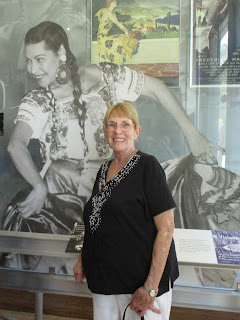So was it "Our Lady" or wasn't it? Until I revisited Olvera Street earlier this month, I'd always believed that the original name of my birthplace was "La Pueblo de Nuestra Senora la Reina de Los Angeles de Porciuncula." I believe I learned that at Budlong Elementary School in sixth grade. The story stuck with me.
The oldest church in the city, built between 1818-1822, always has been called La Iglesia de Nuestra Senora de Los Angeles, Our Lady Queen of Angels Church. But the official brochure I picked up on Olvera Street says this: "The words 'Nuesta Senora' are not part of the city's original name." What?
A little Googling brought up a lot of variations...and a lot of disagreements.
El Pueblo de Nuestra Senora de los Angeles.
El Pueblo de Nuestra Senora la Reyna de los Angeles.
El Pueblo de Nuestra Senora de los Angeles de la Porciuncula.
El Pueblo de Nuestra Senora la Reyna de los Angeles del Rio Porciuncula.
El Pueblo de la Reina de los Angeles Sobre el Rio de Porciuncula.
El Pueblo del Rio de Nuestra Senora la Reyna de los Angeles de Porciuncula.
 |
| Admiring a mural of Dolores Del Rio. |
Thumbing through the book to Page 158, he pointed to a reproduction of a 220-year-old map from UC Berkeley's Bancroft Library.
"You see it at the top of the map, 'El Pueblo de la Reyna de los Angeles.' That's the name on the first handwritten map in 1785. You have to look at the original documents, and that's what we've done. The name is right there." The map uses "Reyna"; other sources spell it "Reina."
A full review of this publication can be found here:
 |
| Linda with a mural promoting the Ramona Pageant |
It's served enchiladas, tacos and Margaritas to hungry local luminaries, and even United States Presidents, including George H. W. and William Jefferson Clinton. I couldn't find out what they dined on, but I feasted on chicken tacos, accompanied by a draft Modelo.
Avila Adobe, built in 1818 by a former Los Angeles alcade (mayor), Francisco José Avila , our next stop, remains the oldest house in Los Angeles.
 |
| Entrance, Avila Adobe |
Our last stop on this scorching afternoon, with temperatures soaring near 100 degrees, turned out to be the America Tropical Interpretative Center, which, thanks to support from the Getty Conservation Institute, has been stabilized and preserved, rather than "restored." David Alfaro Siquieros (1896–1974), a great Mexican artists of the twentieth century, painted América Tropical in 1932 on the second story exterior wall of the Italian Hall, located in the center of Olvera Street. It depicts a Mexican Indian, crucified on a double cross beneath an American eagle, with two sharpshooters taking aim at the eagle from a nearby rooftop. It symbolized American imperialism.
According to a Los Angeles Times article, this mural scandalized L.A. elites who might have expected lush foilage and colorful birds. Consequently, the mural was whitewashed, and Siqueiros deported from the U.S. after his visa ran out.
We wandered through the interesting exhibit hall downstairs, with artifacts and paintings depicting Mexican cultural influences on Los Angeles, before walking up a flight of stairs to the viewing panel for the mural. Though the whitewash covering it has faded, the mural has not been "restored." Nobody else's brush has touched it. It remains purely the work of Siquieros, nearly a century after he painted it.
 |
| Still a hundred percent Siquieros' mural. |
For more on Olvera Street's history:
http://blogdowntown.com/2012/10/7032-historic-olvera-street-siqueiros-mural-museum
http://www.elpueblo.lacity.org/Tourism/OlveraStreetDirectory/index.html


I love reading your informative and fun posts. I like going along for the "ride."
ReplyDelete